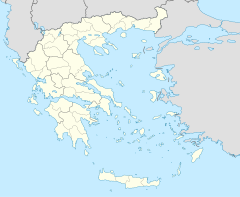The Kursum Mosque (Greek: Κουρσούμ Τζαμί, Turkish: Kurşunlu Camii[1]) is a historical Ottoman-era mosque in the town of Kastoria, Western Macedonia, Greece. The mosque is located close to the old centre of town, on Mitropoleos Street.[2]
| Kursum Mosque Κουρσούμ Τζαμί | |
|---|---|
 Kursum Mosque in 2020 | |
| Religion | |
| Affiliation | Islam |
| Region | Western Macedonia |
| Year consecrated | 15th or 16th century |
| Status | Closed |
| Location | |
| Municipality | Kastoria |
| Country | Greece |
| Geographic coordinates | 40°31′13.3″N 21°15′55.3″E / 40.520361°N 21.265361°E |
| Architecture | |
| Style | Ottoman architecture |
| Specifications | |
| Dome(s) | 1 |
| Minaret(s) | 1 (half-ruined) |
History
editKursum Mosque, named for its lead roof, was the most prominent mosque of Kastoria.[3][2][4] The dating for its construction following the Ottoman conquest is either the fifteenth or sixteenth century.[2][4] Tsamisis and Moutsopoulos wrote it was built on the site of a previous Byzantine church, which in turn was erected on the site of an ancient pagan temple.[2] A turbe or burial monument located within Kursum Mosque's courtyard had four brick walls and arches enclosed by a dome.[5] Under the Ottomans, the mosque functioned as a place of worship for several centuries until Kastoria was annexed by Greece.[2][3] The last imam sold the mosque prior to the departure of the town's Muslim population.[3]
In 1925 the mosque was declared a preserved monument by Greece.[6][7][2] Kastoria municipality attempted in 1935 to get a permit and demolish the mosque for aesthetic reasons.[7] The move was opposed by the local curator and the Ministry of Education, and instead only the mosque portico and nearby turbe was demolished.[7] Unlike several other Ottoman mosques in Kastoria, Kursum mosque was spared destruction due to continuous use.[2] Under Greece, the mosque was initially used as a library, later a museum and its most recent use as an antiquities warehouse, closed to the public.[3][2]
Kursum Mosque is the only surviving mosque in Kastoria in a moderate state of preservation.[3] Most of the external rendering on the walls has fallen off and the mosque has sustained some damage.[3] Left unattended over the years, the mosque is at risk of collapse.[2] Only the lower half of the minaret remains, and the mosque dome is externally covered with plant overgrowth.[2] Internally, the building has good acoustic properties.[4]
In the mid 2010s, interest in the mosque was revived when several students from the Polytechnic School of the Aristotle University of Thessaloniki selected the mosque for their postgraduate studies.[4] Their work, part of the interdepartmental postgraduate program "Protection, maintenance and restoration of cultural monuments", a government initiative, documented the mosque's history and gave suggestions for future uses.[4] The students presence was controversial, as part of the Kastoria municipal council opposed funding their accommodation.[2] Reasons given were a Muslim community was absent in modern Kastoria and opposition toward mosque restorations in Greece while there were discussions in Turkey over converting the Hagia Sophia into a mosque.[2][a] These efforts led to the Kastoria antiquity authority, in cooperation with the Greek Culture Ministry to set aside funds for further study toward restoration and maintenance works.[4]
Later, one million euros were allocated from the Recovery and Resilience Fund toward restoring the mosque.[4] In September 2022 work began by removing soil in and around the mosque and strengthening the building's foundation.[4] During the excavation, the foundations of an older medieval Byzantine basilica and 25 medieval burials containing 47 individuals were uncovered.[4] Other artifacts uncovered were copper coins, metal buttons, glass and clothing fragments.[4] Although yet undetermined, Tsamisis and Orlando said the basilica could have been dedicated to either Panagia (Mary, mother of Jesus) or Saint Paraskevi.[4] The three aisled basilica was converted into a cemetery in the thirteenth century.[4] After the fifteenth century Ottoman conquest, the mosque was built atop the basilica foundations and building material from the church was used for the new structure.[4] Restoration works are set to conclude in 2025, with the mosque coming under Kastoria's jurisdiction for public use and cultural events.[4]
See also
editNotes
edit- ^ Hagia Sophia was converted into a mosque in 2020, several years after the controversy.
References
edit- ^ Bıçakçı, İsmail (2003). Yunanistan'da Türk mimarî eserleri [Turkish architectural works in Greece] (in Turkish). İslâm Tarih, Sanat ve Kültürünü Araştırma Vakfı. pp. 235, 237. ISBN 9789756855041. "Kesriye.... Kurşunlu Camii"
- ^ a b c d e f g h i j k l "Το Τζαμί της Καστοριάς και η ιστορία του" [The Mosque of Kastoria and its history] (in Greek). Fouit. 16 January 2024. Retrieved 27 April 2024.
- ^ a b c d e f Stavridopoulos 2015, p. 267.
- ^ a b c d e f g h i j k l m n Ritzaleou, Maria (20 April 2024). "Καστοριά - Τέμενος Κουρσούμ Τζαμί: Ένα παλίμψηστο της ιστορίας της πόλης" [Kastoria - Kursum Mosque: A palimpsest of the city's history] (in Greek). Voria. Retrieved 27 April 2024.
- ^ Stavridopoulos 2015, pp. 263–264.
- ^ Stavridopoulos, Ioannis (2015). Μνημεία του άλλου: η διαχείριση της οθωμανικής πολιτιστική κληρονομιάς της Μακεδονίας από το 1912 έως σήμερα [Monuments of the other: The management of the Ottoman cultural heritage of Macedonia from 1912 until present] (Ph.D.). University of Ioannina. p. 268. Retrieved 5 May 2024.
- ^ a b c Pateraki, Marilena (2023). "Heritage Policies and Public Memory between Continuity and Rupture: The Treatment of the Ottoman-era Architecture in Greece in the Aftermath of the Population Exchange". Balkanologie. 18 (1). doi:10.4000/balkanologie.5116. para. 36.
Bibliography
edit- Tsamisis, Pantelis (1949). Η Καστοριά και τα μνημεία της [Kastoria and its monuments] (in Greek). Τύποις Ι. Λ. Αλευρόπουλος.
- Moutsopoulos, Nikolaos (1973). Καστοριά. Ιστορία – Μνημεία – Λαογραφία [Kastoria: History-Monuments-Folklore] (in Greek). ΕΕΠΣΑΠΘ.
External links
edit- "Το Κουρσούμ Τζαμί δίχασε την Καστοριά" [Kursum Mosque divided Kastoria]. archaiologia.gr (in Greek). February 22, 2016. Retrieved November 5, 2022.
- Media related to Kursum Mosque at Wikimedia Commons
